Reflecta film scanner i-Scan 3600 test report
In April 2005 reflecta placed with the i-Scan 3600 a follow-up model for the proven i-Scan 1800 on the market. While the predecessor model had a resolution of just 1800 dpi, the new model comes with a nominal resolution of 3600 dpi. In March 2007 the IScan3600 replaced the identically constructed Reflecta SilverScan 3600IE.
The Reflecta i-Scan 3600 was removed from the market in June 2014. There is no successor for it.
This film scanner is for people, who don't have large quantities of films and where time is not important. We tested the device exclusively with the scanning software SilverFast SE and sell it almost ever with this software. This upfront: without SilverFast SE, the scan quality is so insufficient, that we neither publish test reports, nor sell the device as such.
Equipment, accessories and technical facts of the film scanner
Purchasing a Reflecta i-Scan 3600 makes you receive a complete package, which includes the scanner, the power supply, connecting cables, picture-processing software and scanning software; and the software is really something: as scanning software comes the current version of SilverFast SE and
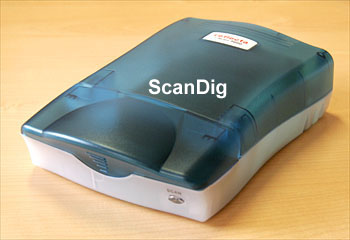 as picture-processing software Adobe® Photoshop® Elements in version 2.0. If one would buy these two programs separately, the price would be higher than that of the scanner itself.
as picture-processing software Adobe® Photoshop® Elements in version 2.0. If one would buy these two programs separately, the price would be higher than that of the scanner itself.
The film scanner with the measures 268 mm x 166 mm x 66 mm (L x W x H) is very compact and takes very little space on the desk. With hardly one kilogram weight it's truly a light-weight among the film scanners and weighs less than some keyboard. The reason for the compact building method and the small weight is due to the absence of any film transportation mechanisms. While expensive film scanners draw in film strips partially fully automatic and also position framed-slide holders, the Reflecta i-Scan 3600 requires manual work, i.e. one must insert each slide individually and must position each picture of a film strip accurately, but later more about this.
The iScan 3600 scans slides or negatives with a linear color CCD. The optical resolution is 3600 dpi; thus the resolution doubled in comparison to the predecessor model. That's a progress! A picture scanned with 3600 dpi delivers an image file with approximately 18 megapixels; thus the scanner beats nearly every usual digital camera. With this count of pixels also large sized prints up to DIN A4 are possible in very good quality.
The scanner gets connected through an USB interface to a PC or MAC. An USB cable is included in the delivery. Unfortunately the scanner comes only with the slow USB 1.1 and not the much faster 2.0. We'll talk later about whether that will affect the speed.
Installation and starting
When purchasing the Reflecta i-Scan 3600, the first positive thing is, that one gets a small, handy cardboard-box with carrying handle, where evyrything is inside: scanner, power supply, USB connection cable as well as CDs with Photoshop® Elements and CyberView software.
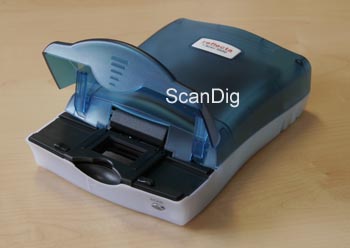 Additionally there's a small installation manual in 6 languages. The SilverFast manual however is only available on CD. But I don't recommend the SilverFast manual anyway, rather take SilverFast - the official book, because through this outstanding book one doesn't just optimally learn everything about SilverFast, one also learns the basic know-how about picture-processing and scanning; it's an extremely valuable book!
Additionally there's a small installation manual in 6 languages. The SilverFast manual however is only available on CD. But I don't recommend the SilverFast manual anyway, rather take SilverFast - the official book, because through this outstanding book one doesn't just optimally learn everything about SilverFast, one also learns the basic know-how about picture-processing and scanning; it's an extremely valuable book!
For the installation it's important to first install Photoshop® and then the scanning software. Only after the installation one is allowed to switch the scanner on - this way nothing should go wrong. I would hold negatively against the scanner, that the power switch is located at the back of the device, so one has to feel around until the switch is found, but since it's such a small device, that's acceptable.
For me the installation under Windows XP was done in a few minutes; afterwards the film scanner could be connected and the first scan accomplished. This went exemplary fast.
Scanning framed slides
The scanning of framed 35mm slides is a very simple thing: first one opens the scanner cover. in order to then open with two small buttons the integrated filmholder flap. Then one inserts the slide, pushes it up to the stop and closes the film flap by simply pushing until it locks. Two springs integrated in the film holder cover keep the inserted slide firm in its position. Then one can start scanning (preview, make adjustments, start main scan).
This sounds easy, fast and comfortable; and indeed one needs only a few moves in order to remove a just scanned slide and insert the next.
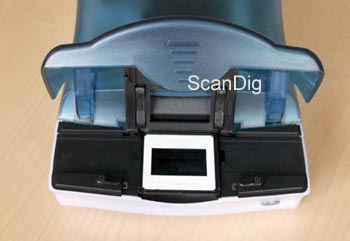 Inserting is a safe affair, because of the fact that one does not run the risk to touch the film layer by mistake. One holds the slide comfortably at the frame to push it in and/or to pull it out. Good is also that the glass stage is lit from below, so it's like having a slide viewer integrated in the scanner.
Inserting is a safe affair, because of the fact that one does not run the risk to touch the film layer by mistake. One holds the slide comfortably at the frame to push it in and/or to pull it out. Good is also that the glass stage is lit from below, so it's like having a slide viewer integrated in the scanner.
After just a few or after hundreds of slides, the constant opening of the protective cover, the unlocking of the film holder flap and opening it, nevertheless becomes a burden - less because of the time needed for it than rather because of the circumstances and the number of moves, above all if one knows how inserting slides works with other scanners, for example with the Reflecta RPS 7200 Professional: insert the slide simply in the slot at the front of the device and that's it. To remove it just press a button. That's where one notices that with an i-Scan 3600 he enjoys less comfort than with some other film scanners. I don't even like to think about batch scanning framed slides, coming in a 4- or 5-pcs. slideholder!
According to manufacturer's data the filmholder can only handle framed slides up to a thickness of 2 mm. It's however possible to carefully insert a 3 mm thick glass slide. One has only to avoid making the mistake to push the internal flap until the springs engage, otherwise the film holder flap will get damaged. Since the heavy glass slide rests flat upon the glass plate, one can accomplish a completely normal scan, even if the filmholder flap is not closed.
The actual scanning with SilverFast takes place as usual (who already knows SilverFast): simple and pleasant. SilverFast offers almost innumerable functions for the picture improvement. An automatic color tone correction seems almost like nothing special.
| Procedure |
Duration |
| Preview |
0:55 min |
| Slide scan with 3600 dpi resolution |
2:05 min |
The above times were achieved on a Pentium IV with 3 gigahertz clock frequency and 2 gigabyte main memory, using an USB 2.0 connection. The measured times make clear, that the scanner actually supports only an USB 1.1 port, because the times are quite long for a scanner without ICE dust- and scratch correction. That's certainly due to the slow data transfer, which could use some improvement.
Scanning film strips, film rolls and single pictures
Scanning 35mm film strips works basically exactly like scanning 35mm slides: one opens the scanner cover, unlocks the film holder flap using the two buttons, opens it then carefully and
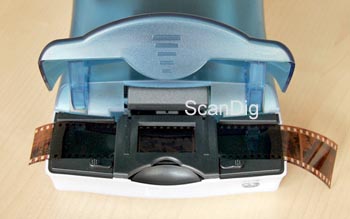 moves the negative strip to the preview window. Since the glass plate is always a little bit lit from below, the exact adjustment of the film strip is easy. Nevertheless this is the point where I noticed the biggest difference to most other film scanners: the negative or positive strip (both can be processed) is not pulled in automatically or positioned exactly by a film holder, which is then drawn in; no, the film strip must indeed be manually inserted and the picture which should be scanned positioned accurately over the film stage. That's of course uncomfortable and time-consuming, but I already mentioned in the introduction, that using the i-Scan, some more manual work is needed than with other film scanners.
moves the negative strip to the preview window. Since the glass plate is always a little bit lit from below, the exact adjustment of the film strip is easy. Nevertheless this is the point where I noticed the biggest difference to most other film scanners: the negative or positive strip (both can be processed) is not pulled in automatically or positioned exactly by a film holder, which is then drawn in; no, the film strip must indeed be manually inserted and the picture which should be scanned positioned accurately over the film stage. That's of course uncomfortable and time-consuming, but I already mentioned in the introduction, that using the i-Scan, some more manual work is needed than with other film scanners.
Nevertheless manual inserting of film strips also has an advantage: the i-Scan 3600 is one of the few scanners on the market, which can process film rolls of any length. The surplus of the film roll is simply hanging over on the left and on the right side of the scanner. With the i-Scan 3600 it's also no problem at all to place an individual positive or negative on the glass stage. Also smaller film fragments or Minox films can be placed and positioned on the scanner without any problems.
Inserting the film strips is however always risky, because it carries the permanent danger that one could leave fingerprints on the film, especially if one processes short film strips or single pictures. In this case I absolutely recommend to wear cotton gloves and to use special tweezers with flattened tips. It would be certainly too bad, if the film strip would become dirty or even destroyed right before his last usage.
When digitizing entire negative strips, of course one misses an automatic pull-in as well as the possibility of processing the whole film strip in batch mode. Whoever wants to digitize larger quantities of negative strips, must be aware of the time and effort required for each individual picture.
| Procedure |
Duration |
| Preview |
0:55 min |
| Negative scan with 3600 dpi resolution |
4:40 min |
The above times were achieved on a Pentium IV with 3,2 gigahertz clock frequency and 2 gigabyte main memory, using an USB 2.0 port and connecting with the supplied cable. The measured times make clear, that the scanner actually supports only an USB 1.1 port, because the times are quite long for a scanner without ICE dust- and scratch correction. That's certainly due to the slow data transfer, which could use some improvement. Even if we disregard the data transfer times, more than 4 minutes scanning time for a single picture is a time-consuming affair; there's no way to process large quantities in one day.
The included software
Reflecta delivers the i-Scan 3600 with a three-piece software package (where one perhaps better doesn't even think of installing the company's CyberView software):
- Scanning software CyberView X-SF
- Scanning software SilverFast SE (optional)
- Picture-processing program Adobe® Photoshop® Elements 2.0
The SilverFast software is the most renowned scanning software on the market, which on the one hand makes an easy start for beginners possible and on the other hand offers sophisticated picture processing functions to professionals. A better scanning software can't be expected when purchasing a film scanner, or maybe yes? There's SilverFast Ai, the professional software made by LaserSoft Imaging. SilverFast Ai supports in contrast to SilverFast SE the IT-8 color calibration and offers a lot more adjustment possibilities.
Adobe® Photoshop® Elements is a slimmed down version of Adobe® Photoshop®, the probably best picture-processing program. The Elements version offers so many functions that many users can't even try them all. The basic picture processing functions, such as enlarge, shrink, crop, rotate, adjustment of colors, brightness and contrast can be accomplished easily and fastly with Photoshop® Elements.
I praised the software package already in the introduction and praise it here again, because the software would individually cost nearly as much as the scanner including the software.
Picture quality
The substantial innovation of the Refelcta i-Scan 3600 in comparison to its predecessor model is the increased resolution from 1800 to 3600 dpi. A resolution test with a USAF-1951 test chart should show, whether the new SilverScan really delivers more details than its predecessor, who was already outstanding with 1800 dpi.
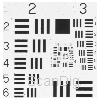
The image here shows the inner part of the scanned USAF testchart with groups 4, 5 and following. As it is the case for most film scanners, one must look at the resolution separately in horizontal and vertical direction regarding this device too. The horizontal resolution results from the stepwidth of the scanning line, while the vertical resolution comes from the individual photodiodes of the CCD line. For the vertical bars element 5.6 is still visible; which corresponds to a resolution of 2900 dpi. In element 5.4 the horizontal bars still clearly differ from the white background, while in element 5.5 it's hardly possible to find difference to the white background. Element 5.4 corresponds to a resolution of 2300 dpi, so in average we get a resolution of 2600 dpi.
Based on the nominal resolution of 3600 dpi, this value means the Reflecta i-Scan 3600 delivers effectively 72% of its nominal resolution. If one considers the fact, that good film scanners reach in practice 90-100% and that flatbed scanners often don't even reach 50% of their nominal resolution, then this is an average value. The scan of a 35mm picture with 2600 dpi produces a picture with approximately 9 megapixels; that's completely sufficient for most applications.
What pictures does the i-Scan 3600 produce? Reflecta indicates the density value as 3.0 Dmax; that means the effective density value is in the range of 2.5. That's a small value and suggests problems in very dark and very bright picture areas. High quality scanners have a density value in the range of 3.0, professional devices reach even the value 4.0. Between these small numbers the picture quality is worlds apart.
Upfront needs to be said, that using the basic software CyberView, the scanner does not produce acceptable picture quality. It's always surprising again, how a scanner shows his true abilities if run with SilverFast. Good to know that SilverFast SE is included in the delivery of this device. Thus the following notes apply only if using Silverfast.
Who scans regular holiday slides or family pictures, will enjoy natural colors, if making a preview of each picture and some color adjustments in SilverFast. Often the simple selection, whether it's a landscape portrait or a picture in the snow and so on, is enough to optimize it. Also often the automatic color adjustments of SilverFast are completely sufficient in order to receive naturally looking good scans.
As not differently expected, the small density value makes it immediately critical, if a dark image, taken for example in the evening or in the shade, or if a very bright image, taken for example with back light, gets scanned. In dark areas of the picture everything becomes dark grey and/or black; the scanner can't make the difference anymore between the different gray tones. Same applies to very bright areas, where everything becomes light-grey and/or white; there the scanner can't recognize the difference between bright and very bright grey.
The demo CD (see below), contains a few scans which have dark shade portions. If one compares the dark fields with the Nikon 5000 scans, also contained on the CD, then one notices the effect clearly, how different dark grey tones nearly become an uniformly dark area; so a lot of image information went lost. Also on the demo CD is a picture, taken on the beach with backlight. The comparison with the Nikon5000-scan shows here too, how picture information in the very bright areas got lost.
When it comes to negatives, I must praise the scanner (and/or the SilverFast software). SilverFast has the so-called NegaFix dialogue, where one can select the accurate type of negative film (brand, designation and speed). This way special color profiles for the specific film are used and one gets substantially better colors compared to using generic profiles. Here SilverFast makes itself once more positively noticed. Fact is, the scanner has the same problems with negative scans in the dark and bright portions, which I already described above with slide scans. That is simply due to the nature of a too small density range.
Summary: thanks to SilverFast, the Reflecta i-Scan 3600 achieves a good image quality, both, with slides and with negatives, if one limits the scanning to regular vacation and family pictures. Those who have one or another sunset or extremely bright pictures in their film archives, will suffer a loss of picture details due to the too small density range.
Scanning speed
The Reflecta i-Scan 3600 scans slides in an acceptable time, which one can use to do other things on the computer. It has to be mentioned positively, that the scanner is very quiet, so it doesn't disturb much while working on the computer, like other scanners do. The scanning time for negatives is however too long. All scanners are slower when scanning negatives, than when scanning positives, but with the SilverScan the time difference is too big.
Compared to some more expensive devices, the i-Scan 3600 performs badly; although the scanning times seem to be ranges averagely; but if one considers that other devices make a scan with ICE dust and scratch correction in the same time, then one understands how slow the SilverScan actually is.
The speed tests in the tables above were accomplished with a fast, well equipped computer, but this doesn't help much, since the film scanner only has an USB 1.1 interface and thus loses a lot of time for the data transfer.
Demo scans CD
If you like to get an idea about the image quality of the Reflecta i Scan 3600, we offer you for an expense contribution of 10 &euro (foreign countries 15 €); a demo CD, which contains scans made with this device. For comparison some Nikon 5000 scans are also contained on the CD, so one can see the difference between the i Scan 3600 and professional equipment. If you like to receive this demo CD, please transfer 10 € to our account (see imprint for bank contact) and mail us your address. Or send us 10 € in an envelope containing your address. The demo CD will be dispatched right after arrival of the money.
Addition: October 2007
When we published this test report in April 2005, Adobe® Photoshop® Elements 2 was contained as picture-processing program in the standard supply. This became replaced by the Presto! ImageFolio and Presto! Mr. Photo software.
Summary, result
The Reflecta i-Scan 3600 is a good film scanner for starters and amateurs, who don't have enormous picture archives to scan and to whom time doesn't matter. The image quality if run with SilverFast SE scanning software is sufficient for people, who simply want to have their photos in the computer; with the standard scanning software the image quality is rather modest. It becomes difficult whenever the picture has very dark or very bright areas.
The device is characterised by a compact built, an acceptable image quality, a praiseworthy software equipment (with SilverFast SE) and a very good price to performance ratio. Positive is the very low noise level, negative the slow speed. Extras like an automatic film strip feed or an automatic dust and scratch correction are of course not offered in this price segment.
Buying a film scanner
Please, feel free to visit our online shop - it's the only shop on the Internet which is fully specialized on film scanners and accessories! We can provide you with any film scanner at an extremely attractive price and we also can supply you with accessories such as film holders or optional adapters.
Back to the film scanner tests index
|